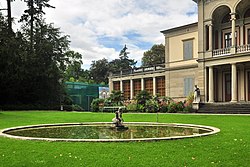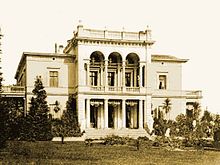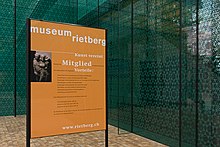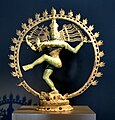Rietberg Museum
 Exterior view of Villa Wesendonck and Smaragd |
|
| Data | |
|---|---|
| place | Zurich-Enge |
| Art |
Non-European art
|
| opening | May 24, 1952 |
| Number of visitors (annually) | 110,000 |
| management |
Annette Bhagwati
|
| Website | |
The Rietberg Museum is a museum for art from Asia , Africa , America and Oceania in Zurich-Enge . It is the only art museum for non-European cultures in Switzerland , the third largest museum in Zurich and the largest museum operated by the city of Zurich itself. It has around 110,000 visitors a year.
Location and building
The museum is located in the 67,000 square meter Rieter Park and consists of several historical buildings: the Villa Wesendonck , the Remise, the Villa Rieter and the Villa Schönberg . On February 17, 2007 the Smaragd extension by the architects Alfred Grazioli and Adolf Krischanitz was opened; this largely underground structure more than doubled the museum's exhibition space.
The Rieterpark is easily accessible by public transport: it is located near the Zurich Enge train station and can be reached via tram line 7 (Museum Rietberg) and bus lines 66 and 72 (Hügelstrasse) operated by the Zurich public transport company .
history

In 1945 the city of Zurich bought the Rieterpark and the Villa Wesendonck. In 1949, a referendum decided to convert the Villa Wesendonck (1951/52 by the architect Alfred Gradmann) into a museum in order to make the collection of Baron Eduard von der Heydt publicly accessible. The baron bequeathed his art collection to the city of Zurich and, with his understanding of an “ars una”, gave the museum its specialty. The concept of «ars una» regards artistic production as being of equal value regardless of its geographical origin. The Rietberg Museum was opened on May 24, 1952. It was headed by Johannes Itten until 1956 , then by Elsy Leuzinger (1956–1972), Eberhard Fischer (1973–1998), Albert Lutz (1998–2019) and Annette Bhagwati (from 2019).
In 1976 the city of Zurich bought the villa Schönberg, which was threatened with demolition and opened in 1978 as an extension of the Rietberg Museum. Today it houses the administration of the museum as well as an extensive reference library.
Since 2007 the new “Smaragd” building has provided exhibition space for large temporary exhibitions, part of the collection and the Schaulager.
collection
The collection includes works from Asia , Africa , America and Oceania as well as a section with Swiss masks. Around 80% of the collection are gifts from private individuals and collectors.
There are objects in the Schaulager that are not currently on display. It is freely accessible to visitors.
Organization and financing
The museum is a service department of the Presidential Department of the City of Zurich. It has around a hundred employees (around 42 full-time positions; as of 2017). Almost half of the financing is provided by the city of Zurich, the other half is generated from operations as well as donations and sponsoring . The collection is expanded primarily through donations.
Artibus Asiae
Artibus Asiae is a biannual trade journal that is published in the Museum Rietberg and specializes in Asian architecture and art.
Exhibitions
A selection of the last exhibitions:
- 2015: World in Color - Color Photography before 1915.
- 2015: Sepik - Art from Papua New Guinea .
- 2016: Dada Africa - Dialogue with the Foreign.
- 2016: Gardens of the World.
- 2017: Osiris - The Sunken Secret of Egypt .
Illustrations
Movies
- Museum check with Markus Brock : Museum Rietberg Zurich. Summary of 3sat. First broadcast: July 24, 2011
literature
- Publications of the Museum Rietberg (catalog of the German National Library)
- Museum Rietberg - The extension: Grazioli and Krischanitz Architects. Edited by the City of Zurich. Verlag Museum Rietberg Zurich, 2007. ISBN 978-3-907077-34-4 .
- Museum Rietberg: founding documents and materials from Eduard von der Heydt. City Archives Zurich VB c.33.
- "I have many favorites": Rietberg Museum Director Albert Lutz on the boom in world art and the style of his house . Züritipp February 14, 2007.
- art-tv on «The Magic of Signs», art-tv, 2015
- SRF cult site on “Osiris - The Sunken Secret of Egypt”, SRF, 2017
Web links
- Official website
- Museum Rietberg as a 3D model in SketchUp's 3D warehouse
Individual evidence
- ↑ Media release «65 years of Rietberg»
- ^ Extension of the Rietberg Museum . Swiss Architects.
- ↑ List of sponsors (website of the Museum Rietberg)
- ↑ Annual report 2007, p. 23f.
- ^ Website Artibus Asiae
Coordinates: 47 ° 21 '32.1 " N , 8 ° 31' 49" E ; CH1903: six hundred and eighty-two thousand four hundred and sixty-nine / 245915














